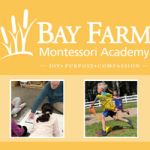An excerpt from the January 2024 issue of the Bay Farm Beat. By Meredith Badders (Middle School Humanities) and Rachael Belsan (Elementary II Lead Teacher).
Reading in America is declining among all facets of people – age, gender, education, income, race, etc. – and the rate of decline is growing at an alarming rate, especially among the young. Why is this happening? As one can probably guess, the introduction of modern technology and electronic interactions has something to do with it. Reading requires a certain level of concentration and attention that technology does not, leading us to quickly reach for our phones over a book. Although we find it incredibly important to embrace technology here at Bay Farm, we feel it is imperative that a passion for reading runs stronger than the draw to reach for technology.
From the very beginning of parenthood, it is obvious how the acquisition of new vocabulary brings about a sense of pride and accomplishment within a child. This vocabulary not only leads to more self-confidence but it allows a child to practice more independence and learn about the world around them through increased social interaction. As one can assume, vocabulary is just the beginning of a child’s language journey, with research showing that “young children whose parents read them five books a day enter kindergarten having heard about 1.4 million words (ScienceDaily).” Ultimately, reading, from the very beginning, opens up a new world of possibilities for a child.
When looking ahead to the upper elementary years, a love for reading boasts a multitude of benefits for this very important age of self-discovery and growth. Here at Bay Farm, our reading curriculum revolves around an exploration of various cultures, perspectives, and genres. This exploratory method allows for cognitive, as well as social and emotional, growth. Research regarding this growth is referenced by many educational organizations such as We Are Teachers and the Child Mind Institute, and below, we have distilled some of those outcomes and how it relates to our strong reading curriculum:
Academically, the benefits of reading are vast. More specifically, by the time your child enters the upper campus here at Bay Farm, a love for reading has, in fact, cultivated a robust vocabulary and access to background knowledge that will help them in all areas of their learning. According to an article by the National Library of Medicine, “much learning of new words occurs through exposure to written texts (Nagy, Herman, & Anderson, 1985; Sternberg, 1987). Because print material generally contains many more low frequency words than does spoken language (Cunningham, 2005), reading text can provide key opportunities for advancement in vocabulary development.” Additionally, when presented with lessons in other content areas such as history or science, students have prior knowledge on various topics from books read during their years prior to fourth grade, which, in turn, inspires confidence in the new material and encourages them to be a more active participant in the lessons. Through cultivating a love for reading, we are also creating strong writers. Roz Morris, an author and writing teacher, states, “Reading exposes us to other styles, other voices, other forms, and other genres of writing. Importantly, it exposes us to writing that’s better than our own and helps us to improve (Warner School of Writing, University of Rochester).” Because of this, in our upper campus classrooms, we are consistently working to diversify what our students read, allowing them to enhance their worldview, gain new perspectives, and gain new knowledge, vocabulary, and context. Lastly, the research that correlates reading with critical thinking and problem-solving is fascinating and more than enough reason to bring out the books in our classrooms and homes. In our upper campus classrooms, we don’t just passively read, the students are actively reading with the use of comprehension strategies such as questioning, predicting, summarizing, connecting, and more. These strategies simulate what it means to problem-solve and think critically; students are identifying plot elements such as conflict, analyzing and evaluating events and characters’ actions, making connections, and providing inferences or predictions based on their understanding of the text and any prior knowledge that they may have. Recent research using MRI scans confirmed that “reading involves a complex network of circuits and signals in the brain. As your reading ability matures, those networks also get stronger and more sophisticated.” It goes without saying that reading creates some seriously wonderful connections in the developing brain.
Socially and emotionally, reading has equal benefits for the developing mind. Our upper campus reading curriculum, as mentioned earlier, revolves around diversity of culture, perspective, and genre. The reason for this is that it opens students’ worldviews, allowing them to see outside of their own, developmentally appropriate, small world. Expanding upon this world is the work of parents, educators, and, of course, reading. Not only does reading from diverse perspectives build this worldview, it allows for students to learn about emotional awareness and how to handle issues such as grief, tragedy, or heartbreak. Even if your child is not familiar with tough concepts such as a death in the family or an unrelenting hardship, reading about characters that experience these issues will allow for them to build prior knowledge on how to handle it one day, how to empathize with others who may be experiencing something similar, and how to connect with their peers based on a shared vulnerability and understanding.
The benefits outlined above are immense. Due to this, Bay Farm’s upper campus reading curriculum strives to create a curriculum that maintains and cultivates a passion for reading. Below, we have outlined a variety of ways in which we meet curricular reading goals, but in a way that maximizes problem-solving, critical thinking, collaboration, and perspective building. When older students are entrusted to be creative, unique, and social during their academic reading experiences, that is where fun and learning collide!
- Storyboarding and Skits: Students are often tasked with storyboarding (similar to a comic strip or picture book) the main events within a novel. Within this task, they often work alongside a partner to identify the main plot elements of a storyline (exposition, rising action, climax, falling action, and resolution). Once these storyboard elements are complete, students can read their storyboards to younger students, which is a wonderful way to articulate a more complex storyline to developing readers, or they can perform a skit of the “scenes” to their larger classroom of peers. Ultimately, this one activity can allow for a deeper understanding of the text, but through creativity, analysis skills, and most importantly, to an adolescent, a deeper connection with their peers.
- One-pagers: Throughout our novel studies, students are often assigned an assignment called a “one-pager” in which they are tasked with filling in blank spaces with something specific to their understanding of the novel; for example, one square might be about characterization, one might be about theme, and the others might be about symbolism, figurative language, and personal connections. During this process, the student is able to use their creative approach of sketches, words, and colors, allowing them to focus on what they find important or interesting within the novel, while also showing off very real comprehension and analytical skills such as their ability to identify plot structure, themes, and figurative language. This open-endedness is not only fun for the students, but it allows them to connect with themselves in regards to creativity, decision-making, and their own, unique connection with the novel.
- Quote Analysis and Reading Responses: Within our reading units, students will often be seen analyzing quotes or responding to reading response questions. These activities first and foremost teach students how to think critically about a piece of the text or a specific event, pushing them to relate these concepts to a larger theme within the novel. Secondly, most of these assignments are done in tandem with a peer, which helps students bounce their own understanding off of one another, come to conclusions about deeper meaning, and then use their collaborative skills to write a clear claim or analysis. On top of the academic and social skills gained here, they are also learning how to hear others’ perspectives, agreeing or disagreeing, and finding a way to collaborate on a response.
- Book Discussions: Most of our novels end with a formal literature circle discussion in which students prepare for a full-novel conversation that covers the answering of teacher and self-created discussion questions, the sharing of characterization, figurative language, symbolism, and theme, and student connections or reviews of the novel. Our upper campus carefully leads our students into this activity through a gradual release of responsibility, meaning that your younger students are provided with discussion questions and a very clear guide on the discussion, while your older, more analytical readers are possibly given more flexibility with creating their own discussion questions and deciding on what literary concepts are covered within the discussion. These discussions not only increase confidence in the formulation of ideas, they encourage students to make stronger connections and understanding through listening to their peers and teachers. Additionally, on a social-emotional level, students work with their teachers to come up with expectations for literature discussion norms, specifically identifying ways to handle differing perspectives and understanding. For example, we learn how to give constructive feedback, agree to disagree, provide research to counter someone’s answer, and more. Additionally, students learn how to take turns, stop and think if two people are speaking at once, and understand how tone can impact how you are perceived. As you can see, our reading curriculum is deeply immersed in ways to help students connect with their peers, themselves, and their understanding of the world.
Knowing how valuable reading is to the academic and social-emotional success of a child, our reading curriculum here at Bay Farm is entrenched in the understanding that reading needs to be enjoyable, relatable, collaborative, and diverse. To finalize this article, we will leave you with some ideas on how you can do the same at home:
- Visit the Library – make it a fun, routine outing!
- Read aloud with your child – they are never too old!
- Ride and Read – listen to audiobooks in the car!
- Read and Chat – read a novel alongside your child and discuss as you go!
Happy Reading!

